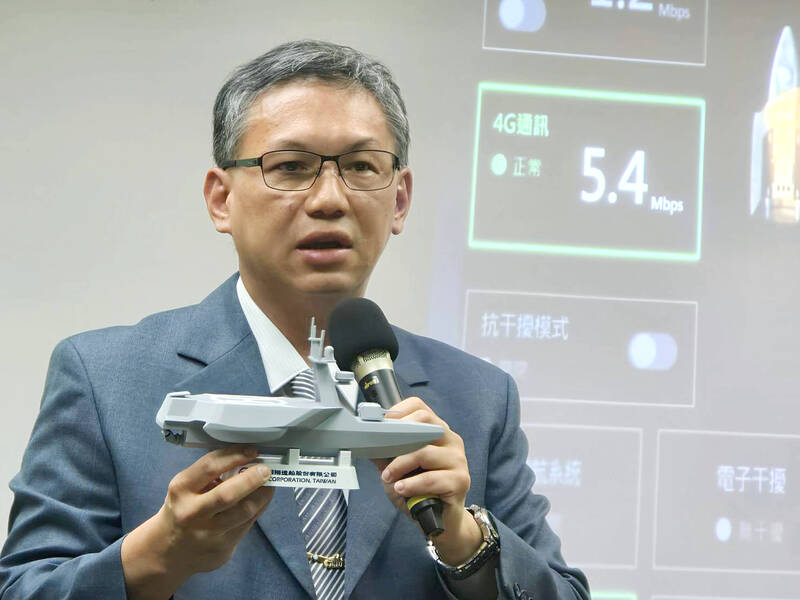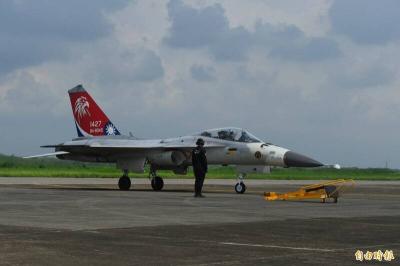CSBC Corp, Taiwan is expected to be able to produce 40 Endeavor Mantas — the company’s military-grade uncrewed surface vessel (USV) — per year, with all components guaranteed to be from non-Chinese sources, the firm said yesterday.
The company made the statement yesterday at a news conference showcasing the Manta and its remote control capabilities.
The ship’s first public appearance was on March 25, but the version showcased yesterday featured an expanded rear flight deck that would allow drones to dock, while the Manta is capable of carrying its own drones under its main deck, CSBC deputy general manager Chou Chih-ming (周志明) said.

Photo: Wang Yi-hung, Taipei Times
CSBC chairman Chen Cheng-hung (陳政宏) said the company had selected a trimaran hull for the ship to counter rough seas in the Taiwan Strait, adding that the company is looking to develop a rescue ship version of the Manta.
The company would be able to provide one hull every seven to 10 days on a single production line, and 40 hulls per year, to satisfy the navy’s orders, Chou said.
None of the components, from large to small, were made in China, and the software used on the ship was developed by a joint venture between domestic and foreign companies, excluding China, Chou added.
Asked about the attack capabilities of the USV, the company’s general manager Tsai Kun-tsung (蔡坤宗) said it was capable of conducting kamikaze attacks or being outfitted with torpedoes, adding that the company has completed tests.
Demonstrations of the ship being remotely controlled from Taipei in Kaohsiung Harbor would be made available at the Taipei Aerospace and Defense Technology Exhibition.
The three-day exhibition is to open today in Hall 1 of the Taipei Nangang Exhibition Center.
Separately, the company said that sea acceptance tests (SATs) for the Hai Kun (海鯤) indigenous developed submarine, would not be completed this month.
The company would do everything within its power to ensure that the submarine meets the delivery deadline for November, but the company must ensure that the submarine is safe to use and meets standards, Chen said.
Chen declined to comment on whether the as-yet undelivered periscope would cause further delays or require fresh tests, and said the matter falls squarely in the jurisdiction of the navy.
Asked whether CSBC leadership would be on board the Hai Kun when it conducts diving tests, as pledged by former convener of the indigenous submarine program Huang Shu-kuang (黃曙光), Tsai said submarines have tight quarters, and even he, as the executive officer of the program, cannot say if he would participate in the test.
Huang’s comments were meant more as a reassurance to the public, as submarines have to undergo multiple examinations and checkups of crucial systems before diving tests, Tsai said.
There were contingencies regarding potential need for rescue operations, Tsai said, adding that he was not at liberty to discuss classified information.

LOW RISK: Most nations do not extradite people accused of political crimes, and the UN says extradition can only happen if the act is a crime in both countries, an official said China yesterday issued wanted notices for two Taiwanese influencers, accusing them of committing “separatist acts” by criticizing Beijing, amid broadening concerns over China’s state-directed transnational repression. The Quanzhou Public Security Bureau in a notice posted online said police are offering a reward of up to 25,000 yuan (US$3,523) for information that could contribute to the investigation or apprehension of pro-Taiwanese independence YouTuber Wen Tzu-yu (溫子渝),who is known as Pa Chiung (八炯) online, and rapper Chen Po-yuan (陳柏源). Wen and Chen are suspected of spreading content that supported secession from China, slandered Chinese policies that benefit Taiwanese and discrimination against Chinese spouses of

ALIGNED THINKING: Taiwan and Japan have a mutual interest in trade, culture and engineering, and can work together for stability, Cho Jung-tai said Taiwan and Japan are two like-minded countries willing to work together to form a “safety barrier” in the Indo-Pacific region, Premier Cho Jung-tai (卓榮泰) yesterday said at the opening ceremony of the 35th Taiwan-Japan Modern Engineering and Technology Symposium in Taipei. Taiwan and Japan are close geographically and closer emotionally, he added. Citing the overflowing of a barrier lake in the Mataian River (馬太鞍溪) in September, Cho said the submersible water level sensors given by Japan during the disaster helped Taiwan monitor the lake’s water levels more accurately. Japan also provided a lot of vaccines early in the outbreak of the COVID-19 pandemic,

PROMOTION: Travelers who want a free stopover must book their flights with designated travel agents, such as Lion Travel, Holiday Tours, Cola Tour and Life Tours Air Canada yesterday said it is offering Taiwanese travelers who are headed to North America free stopovers if they transit though airports in Japan and South Korea. The promotion was launched in response to a potential rise in demand for flights to North America in June and July next year, when the US, Canada and Mexico are scheduled to jointly host the FIFA World Cup, Air Canada said. Air Canada offers services to 13 of the 16 host cities of the tournament’s soccer games, including Toronto and Vancouver; Mexico City, Guadalajara and Monterrey in Mexico; Atlanta, Georgia; Boston; Dallas; Houston;

The US approved the possible sale to Taiwan of fighter jet spare and repair parts for US$330 million, the Pentagon said late yesterday, marking the first such potential transaction since US President Donald Trump took office in January. "The proposed sale will improve the recipient's capability to meet current and future threats by maintaining the operational readiness of the recipient's fleet of F-16, C-130," and other aircraft, the Pentagon said in a statement. Trump previously said that Chinese President Xi Jinping (習近平) has told him he would not invade Taiwan while the Republican leader is in office. The announcement of the possible arms